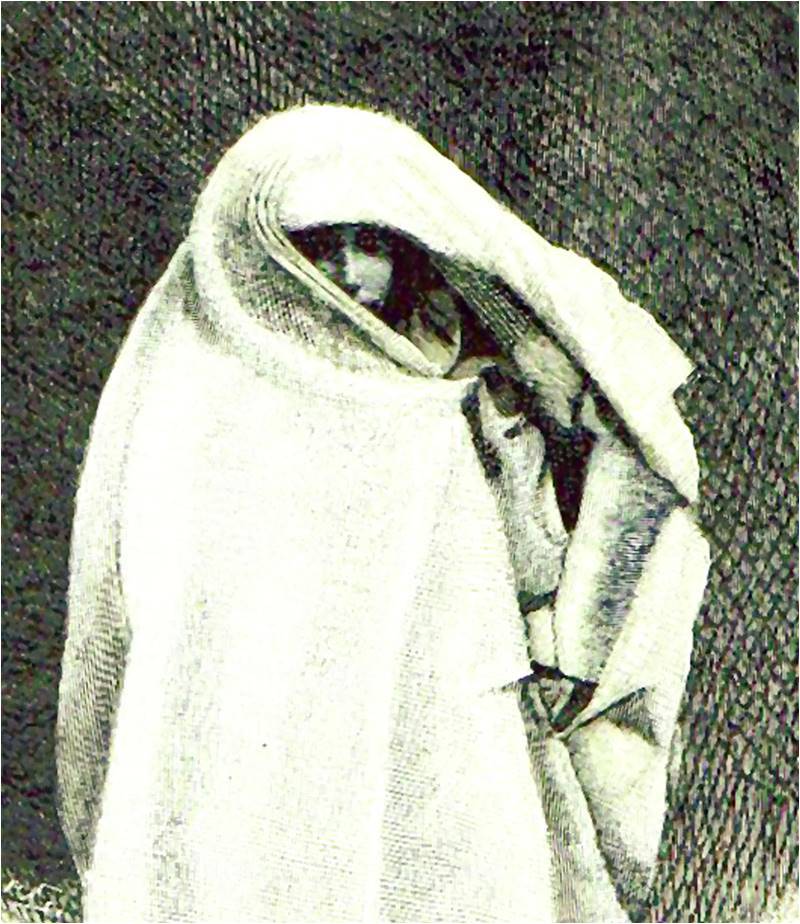
This image has been taken from A travers le Maroc. Notes et croquis d’un artiste (Among the Moors: Sketches of Oriental Life) by George Montbard - a French artist, illustrator and caricaturist.
George was born in Montbard on August 2, 1841. His father was a tax inspector.
Under the Second French Empire, he published a caricature of Victor Hugo and another of Sainte-Beuve in 1867 in Le Masque, a theatrical weekly. The following year, he published another caricature of Hugo in Gulliver, a satirical weekly. Under the title Romanticism, Hugo was depicted in a medieval setting as the flag-bearer of the Romantic Movement. His drawings also appeared in La Rue, a periodical published by his friend Jules Vallès, as well as in satirical publications such as Le Monde illustré (1880) and L’Eclipse. He also published a single issue of his own weekly satirical periodical, La Fronde illustrée.
In My Days of Adventure; The Fall of France, 1870–71, Ernest Alfred Vizetelly, who had hired Montbard as an illustrator, writes that at that time Montbard “was a Republican—in fact, a future Communard” and did not appreciate an unexpected meeting in the street with Napoleon III, who took an interest in the sketch he was making. He refused to shave his “revolutionary beard” at the request of the chamberlain.
Montbard became actively involved in the Paris Commune in 1871. His friend, the illustrator Andre Gill, thought that he had died on the battlefield. In fact Montbard had fled to London to escape the loyalist Versaillais troops, sending his drawings from there to Le Monde illustré and L’Eclipse and also working for several London periodicals.
In 1872, he illustrated the riots in Ireland for the Illustrated London News. His caricature of Léon Gambetta, also published in Vanity Fair on 19 October 1872, bears the caption: “He devoured France with activity.” In 1876, Henri Bellenger published Londres pittoresque et la vie anglaise, with eight drawings by Montbard. In 1882, Vincent van Gogh, who was also working for the Illustrated London News, mentioned receiving illustrations by him of the Channel Islands.
Even after the amnesty of 1880, Montbard remained in London, where he married.
For Montbard, art was an opportunity to share his political views. He did not confine himself to drawing and watercolours; he also painted in oils. He travelled extensively, particularly to the Maghreb. This was also the period of the beginnings of photography, which came to compete with the illustrator’s art. This is why, albeit with some humour, Montbard writes of it in Among the Moors as “producing... a deformed and lugubrious picture of men and things” and possibly constituting “a terrible engine of destruction, an explosive substance that was destined to pulverise the world of art.”
In 1896, he illustrated Rudyard Kipling’s poem The ‘eathen for Pearson’s Magazine.
George was born in Montbard on August 2, 1841. His father was a tax inspector.
Under the Second French Empire, he published a caricature of Victor Hugo and another of Sainte-Beuve in 1867 in Le Masque, a theatrical weekly. The following year, he published another caricature of Hugo in Gulliver, a satirical weekly. Under the title Romanticism, Hugo was depicted in a medieval setting as the flag-bearer of the Romantic Movement. His drawings also appeared in La Rue, a periodical published by his friend Jules Vallès, as well as in satirical publications such as Le Monde illustré (1880) and L’Eclipse. He also published a single issue of his own weekly satirical periodical, La Fronde illustrée.
In My Days of Adventure; The Fall of France, 1870–71, Ernest Alfred Vizetelly, who had hired Montbard as an illustrator, writes that at that time Montbard “was a Republican—in fact, a future Communard” and did not appreciate an unexpected meeting in the street with Napoleon III, who took an interest in the sketch he was making. He refused to shave his “revolutionary beard” at the request of the chamberlain.
Montbard became actively involved in the Paris Commune in 1871. His friend, the illustrator Andre Gill, thought that he had died on the battlefield. In fact Montbard had fled to London to escape the loyalist Versaillais troops, sending his drawings from there to Le Monde illustré and L’Eclipse and also working for several London periodicals.
In 1872, he illustrated the riots in Ireland for the Illustrated London News. His caricature of Léon Gambetta, also published in Vanity Fair on 19 October 1872, bears the caption: “He devoured France with activity.” In 1876, Henri Bellenger published Londres pittoresque et la vie anglaise, with eight drawings by Montbard. In 1882, Vincent van Gogh, who was also working for the Illustrated London News, mentioned receiving illustrations by him of the Channel Islands.
Even after the amnesty of 1880, Montbard remained in London, where he married.
For Montbard, art was an opportunity to share his political views. He did not confine himself to drawing and watercolours; he also painted in oils. He travelled extensively, particularly to the Maghreb. This was also the period of the beginnings of photography, which came to compete with the illustrator’s art. This is why, albeit with some humour, Montbard writes of it in Among the Moors as “producing... a deformed and lugubrious picture of men and things” and possibly constituting “a terrible engine of destruction, an explosive substance that was destined to pulverise the world of art.”
In 1896, he illustrated Rudyard Kipling’s poem The ‘eathen for Pearson’s Magazine.

